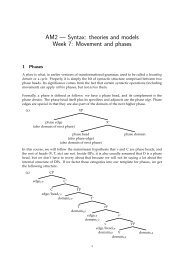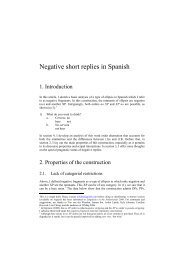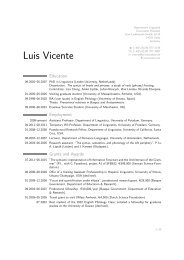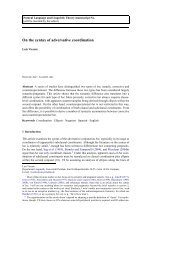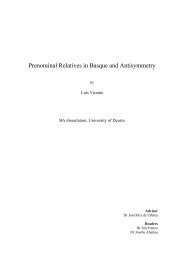Verb fronting in Mandarin Chinese - Luis Vicente
Verb fronting in Mandarin Chinese - Luis Vicente
Verb fronting in Mandarin Chinese - Luis Vicente
Create successful ePaper yourself
Turn your PDF publications into a flip-book with our unique Google optimized e-Paper software.
Cheng & <strong>Vicente</strong><br />
<strong>Verb</strong> <strong>front<strong>in</strong>g</strong> <strong>in</strong> Mandar<strong>in</strong><br />
UCSC L<strong>in</strong>guistics Colloquium<br />
October 31, 2008<br />
Focus falls on the constituent immediately follow<strong>in</strong>g shi. S<strong>in</strong>ce focalized constituents are clearly displaced<br />
with<strong>in</strong> the small clause subject, we may assume a specialized focus projection.<br />
(15) shi [ SC Taibei ta qu-guo t ] (bu shi Taizhong)<br />
cop Taipei he go.asp not cop Taizhong<br />
“It is Taipei that he went to, and not Taizhong”<br />
Non-verbal clefts have a contrastive focus read<strong>in</strong>g –i.e., the denotation of the focused constituent is<br />
contrasted aga<strong>in</strong>st a set of Roothian alternatives. On the other hand, verbal clefts have a verum focus<br />
read<strong>in</strong>g, where it is the truth value of the proposition that is contrasted aga<strong>in</strong>st the opposite truth<br />
value. <strong>Verb</strong>al clefts also give rise to an adversative implicature (a but effect), which may be only<br />
implicit.<br />
(16) chi,<br />
eat<br />
wo<br />
I<br />
shi chi-guo le, bu guo. . .<br />
cop eat.asp sfp but<br />
“As for eat<strong>in</strong>g, it is true that I have eaten, but (I still feel hungry)”<br />
Note also that verbal clefts have a preference for lett<strong>in</strong>g the lower copy of the verb be the rightmost<br />
element <strong>in</strong> the clause. We don’t have anyth<strong>in</strong>g <strong>in</strong>terest<strong>in</strong>g to say about this.<br />
(17) a. ? chi, wo shi chi-guo zhe-zhong mian<br />
eat I cop eat.asp this.k<strong>in</strong>d noodle<br />
“As for eat<strong>in</strong>g, it is true that I’ve eaten this k<strong>in</strong>d of noodles”<br />
b. zhe-zhong mian chi, wo shi chi-guo<br />
this.k<strong>in</strong>d noodle eat I cop eat.asp<br />
“As for eat<strong>in</strong>g, it is true that I’ve eaten this k<strong>in</strong>d of noodles”<br />
2.2 <strong>Verb</strong>al clefts <strong>in</strong>volve movement<br />
There is evidence that, <strong>in</strong> several other languages featur<strong>in</strong>g verb doubl<strong>in</strong>g (Hebrew, Spanish, Hungarian,<br />
Yiddish, Russian, Nupe, Vata, several creoles. . .) the two copies of the verb are l<strong>in</strong>ks of one and the<br />
same movement cha<strong>in</strong>. The same holds for Mandar<strong>in</strong>.<br />
2.2.1 Argument for movement #1: locality effects<br />
The two copies of the verb can be separated by f<strong>in</strong>ite clause boundaries.<br />
(18) Q: Zhangsan kan-guo zhe-bu diany<strong>in</strong>g ma?<br />
Zhangsan see.asp this.cl movie Q<br />
“Has Zhangsan seen this movie?”<br />
A: kan, wo xiangx<strong>in</strong> [ CP ta [shi kan-guo]], bu guo...<br />
see I believe he cop see.asp although<br />
“As for see<strong>in</strong>g, I believe that he has <strong>in</strong>deed seen it, but...”<br />
Nonetheless, island boundaries cannot <strong>in</strong>tervene between the two copies. This is illustrated here with<br />
a complex NP island and an adjunct island.<br />
(19) a. * kan, wo tongyi [ NP nei-ge ta [shi kan-guo (yici) de] kanfa]<br />
see I agree that.cl he cop see.asp once de op<strong>in</strong>ion<br />
“As for see<strong>in</strong>g, I agree with the op<strong>in</strong>ion that he has <strong>in</strong>deed seen it once”<br />
4 of 13



